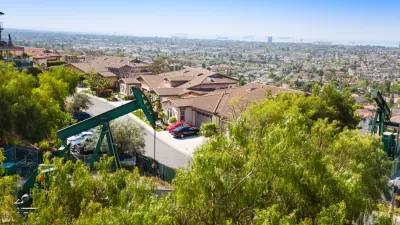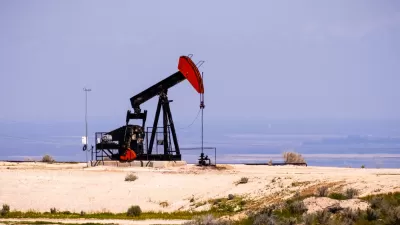What a revision! The EIA changed the recoverable oil reserves in California's vast Monterey Shale formation from 13.7 billion barrels to 600 million barrels using existing technology. Also, for the first time, a California county banned fracking.
The Energy Information Administration (EIA) is expected to release the revised estimates next month in what will be "a blow to the nation's oil future", writes Louis Sahagun, and also a disappointment for the state's economy. Sacramento was hoping that the new drilling would bring "2.8 million new jobs to California and boost tax revenue by $24.6 billion annually" according to a 2013 University of Southern California analysis [PDF].
"The Monterey Shale formation (see map) contains about two-thirds of the nation's shale oil reserves," writes Sahagun. So what caused the downward revision of recoverable oil from the formation?
The energy agency said the earlier estimate of recoverable oil, issued in 2011 by an independent firm under contract with the government, broadly assumed that deposits in the Monterey Shale formation were as easily recoverable as those found in shale formations elsewhere.
It isn't, thanks to California's geology - particularly its seismic activity.
Unlike heavily fracked shale deposits in North Dakota and Texas, which are relatively even and layered like a cake, Monterey Shale has been folded and shattered by seismic activity, with the oil found at deeper strata.
Sierra Club California, a strong opponent of fracking that has been advocating a moratorium included in Senate Bill 1132, greeted the news with caution. "The new estimates won't discourage the oil companies and oil industry service companies", states their press release.
Indeed, Tupper Hull, spokesman for the Western States Petroleum Association, stated, "We have a lot of confidence in the intelligence and skill of our engineers and geologists to find ways to adapt."
On the political front, Santa Cruz County became the first to ban fracking in the state with the Board of Supervisor's unanimous 5-0 vote, writes Jason Hoppin of the Santa Cruz Sentinel.
The move, however, is largely symbolic: There are no known oil leases in Santa Cruz County, nor has it been targeted by oil prospectors.
But other counties with proven oil reserves may follow. "Butte, Santa Barbara and San Benito counties are all considering fracking bans. Beverly Hills also recently passed a ban, becoming the first city to do so."
FULL STORY: U.S. officials cut estimate of recoverable Monterey Shale oil by 96%

Maui's Vacation Rental Debate Turns Ugly
Verbal attacks, misinformation campaigns and fistfights plague a high-stakes debate to convert thousands of vacation rentals into long-term housing.

Planetizen Federal Action Tracker
A weekly monitor of how Trump’s orders and actions are impacting planners and planning in America.

San Francisco Suspends Traffic Calming Amidst Record Deaths
Citing “a challenging fiscal landscape,” the city will cease the program on the heels of 42 traffic deaths, including 24 pedestrians.

Half of Post-Fire Altadena Home Sales Were to Corporations
Large investors are quietly buying up dozens of properties in Altadena, California, where a devastating wildfire destroyed more than 6,000 homes in January.

Opinion: What San Francisco’s Proposed ‘Family Zoning’ Could Really Mean
Mayor Lurie is using ‘family zoning’ to encourage denser development and upzoning — but could the concept actually foster community and more human-scale public spaces?

Jacksonville Launches First Autonomous Transit Shuttle in US
A fleet of 14 fully autonomous vehicles will serve a 3.5-mile downtown Jacksonville route with 12 stops.
Urban Design for Planners 1: Software Tools
This six-course series explores essential urban design concepts using open source software and equips planners with the tools they need to participate fully in the urban design process.
Planning for Universal Design
Learn the tools for implementing Universal Design in planning regulations.
Gallatin County Department of Planning & Community Development
Heyer Gruel & Associates PA
JM Goldson LLC
City of Camden Redevelopment Agency
City of Astoria
Transportation Research & Education Center (TREC) at Portland State University
Jefferson Parish Government
Camden Redevelopment Agency
City of Claremont




























